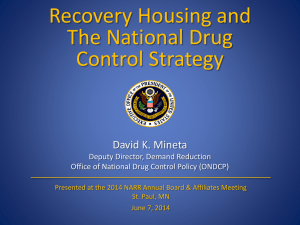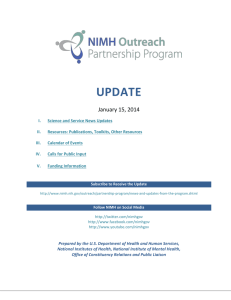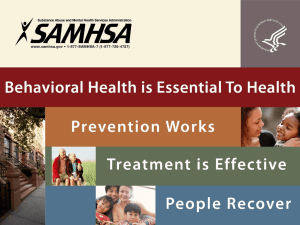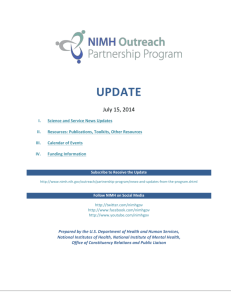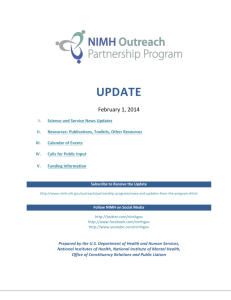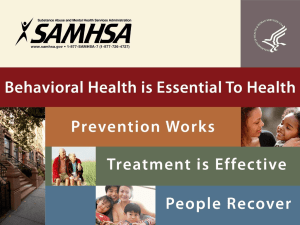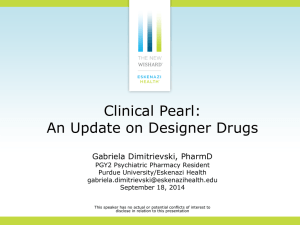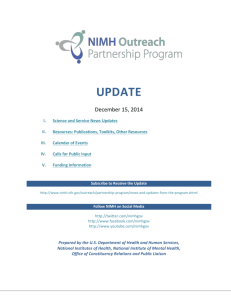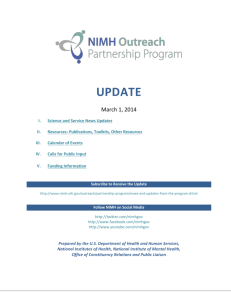HERE - NAMI Iowa
advertisement
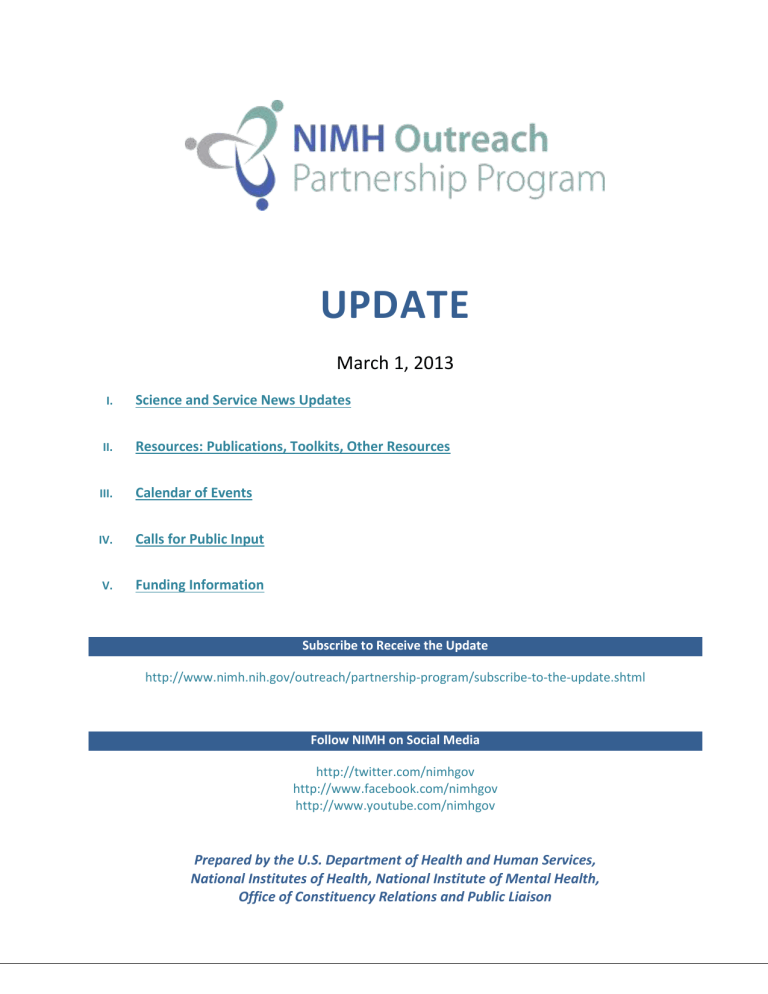
UPDATE March 1, 2013 I. Science and Service News Updates II. Resources: Publications, Toolkits, Other Resources III. Calendar of Events IV. Calls for Public Input V. Funding Information Subscribe to Receive the Update http://www.nimh.nih.gov/outreach/partnership-program/subscribe-to-the-update.shtml Follow NIMH on Social Media http://twitter.com/nimhgov http://www.facebook.com/nimhgov http://www.youtube.com/nimhgov Prepared by the U.S. Department of Health and Human Services, National Institutes of Health, National Institute of Mental Health, Office of Constituency Relations and Public Liaison March 1, 2013 SCIENCE AND SERVICE NEWS UPDATES MAPPING BRAIN CIRCUITS PROVIDES CLUES TO SCHIZOPHRENIA, EARLIER DETECTION OF PSYCHOSIS Two regions in the brain have been linked to schizophrenia and psychosis, which may lead to earlier detection of this disorder, reported an imaging study funded by the National Institute of Mental Health (NIMH) that was published online last month in Biological Psychiatry. Science Update: http://www.nimh.nih.gov/science-news/2013/mapping-brain-circuits-provides-clues-toschizophrenia-earlier-detection-of-psychosis.shtml 5 MAJOR MENTAL ILLNESSES SHARE THE SAME GENES An NIMH-funded study published online in Lancet reveals that the five most common disorders—autism, attention deficit hyperactivity disorder, bipolar disease, schizophrenia, and major depression—all share similar genetic components. Science Update: http://www.nimh.nih.gov/science-news/2013/5-most-common-mental-illnesses-sharethe-same-genes.shtml DIFFERENCES IN ON/OFF SWITCHES HELP EXPLAIN HOW THE HUMAN BRAIN EVOLVED The evolution of human brain function may be more dependent on mechanisms that turn genes on and off, rather than on changes in DNA sequences. A recent NIMH-funded study identified small regions of the genome that are uniquely regulated in human neurons, but not in primate neurons. The findings provide insight into human intellectual function and risk for human diseases, including autism and Alzheimer’s disease. Press Release: http://www.nimh.nih.gov/science-news/2013/differences-in-on-off-switches-help-explainhow-the-human-brain-evolved.shtml SCIENTISTS IDENTIFY MOLECULAR EVENTS THAT UNDERLIE FASD Scientists have identified a molecular signaling pathway that plays an important role in the development of fetal alcohol spectrum disorders (FASD). The new research in cells and mice, supported by the National Institute on Alcohol Abuse and Alcoholism (NIAAA), points to candidate genes for FASD susceptibility and may open new avenues for developing drugs to prevent alcohol damage to the fetal brain. A report of the study is now online in the Proceedings of the National Academy of Sciences. Press Release: http://www.nih.gov/news/health/feb2013/niaaa-20.htm March 1, 2013 OPIOIDS DRIVE CONTINUED INCREASE IN DRUG OVERDOSE DEATHS; DRUG OVERDOSE DEATHS INCREASE FOR 11TH CONSECUTIVE YEAR Drug overdose deaths increased for the 11th consecutive year in 2010, according to an analysis from the Centers for Disease Control and Prevention (CDC). The findings are published in a research letter, “Pharmaceutical Overdose Deaths, United States, 2010,” in the Journal of the American Medical Association. CDC’s analysis shows that 38,329 people died from a drug overdose in the United States in 2010, up from 37,004 deaths in 2009. This continues the steady rise in overdose deaths seen over the past 11 years, starting with 16,849 deaths in 1999. Overdose deaths involving opioid analgesics have shown a similar increase. Starting with 4,030 deaths in 1999, the number of deaths increased to 15,597 in 2009 and 16,651 in 2010. Press Release: http://www.cdc.gov/media/releases/2013/p0220_drug_overdose_deaths.html SAMHSA’S INFORMATION RESOURCE CENTER PROVIDES INFORMATION ON HOW THE AFFORDABLE CARE ACT BENEFITS BEHAVIORAL HEALTH CARE The Substance Abuse and Mental Health Service Administration’s (SAMHSA) Center for Financing Reform and Innovations has developed a new Information Resource Center to provide people in the behavioral health care field important information about how the Affordable Care Act (ACA) can improve access to behavioral healthcare services. The Information Resource Center can answer many of the specific questions about how the ACA will affect various aspects of the behavioral health care community, as well as provide updates on the status of the ACA’s implementation. Press Release: http://www.samhsa.gov/newsroom/advisories/1302204644.aspx HHS ANNOUNCES 25 STATE INNOVATION MODEL AWARDS The U.S. Department of Health and Human Services (HHS) announced the first recipients of the State Innovation Models initiative awards. Twenty-five states will be working to design and implement improvements to their health care systems that will bolster health care quality and decrease costs. Made possible by the ACA, nearly $300 million in awards will support the development of models of care that will transform health care delivery throughout the states. Over $250 million in Model Testing awards will fund six states – Arkansas, Maine, Massachusetts, Minnesota, Oregon, and Vermont – in implementing their plans for health care delivery transformation. These states will use these funds to test multi-payer payment and service delivery models on a broader scale within their state. An additional 19 states will receive nearly $35 million to develop their State Health Care Innovation Plans that will guide comprehensive health care transformation. Press Release: http://www.hhs.gov/news/press/2013pres/02/20130221a.html March 1, 2013 RESOURCES: PUBLICATIONS, TOOLKITS, OTHER RESOURCES NEW ON THE NIMH WEBSITE DIRECTOR’S BLOG: THE FOUR KINGDOMS OF AUTISM NIMH Director Thomas Insel describes how different perspectives separate the communities interested in autism, and suggests the common ground that would provide an avenue to move forward. http://www.nimh.nih.gov/about/director/2013/the-four-kingdoms-of-autism.shtml NIH RESEARCH MATTERS: PREDICTING TREATMENT RESPONSE TO A RAPID ANTIDEPRESSANT Brain activity during specific tasks may predict how well patients with major depressive disorder respond to the experimental antidepressant scopolamine. The finding suggests that brain imaging might help identify good candidates for the treatment. http://www.nih.gov/researchmatters/february2013/02252013antidepressant.htm STAFF STRESS AFFECTS PATIENTS’ ENGAGEMENT IN THERAPY A study supported by the National Institute on Substance Abuse suggests that outpatient drug-free programs can help substance abuse treatment professionals reduce their stress and more effectively engage patients in treatment. http://www.drugabuse.gov/news-events/nida-notes/2013/02/staff-stress-affectspatients-engagement-in-therapy LATEST ISSUE OF NIAAA SPECTRUM The latest issue of NIAAA’s Spectrum online webzine features the work of NIAAA’s Health Disparities Research Program which is enhancing research efforts and collaborating across and beyond NIH to study the unique alcohol-related issues facing minorities. http://www.spectrum.niaaa.nih.gov/ March 1, 2013 ASPE ISSUE BRIEF: AFFORDABLE CARE ACT AND FEDERAL PARITY This issue brief developed by the HHS Assistant Secretary for Planning and Evaluation (ASPE) looks at how The ACA will build on the Mental Health Parity and Addiction Equity Act of 2008. The parity law aims to ensure that when coverage for mental health and substance use conditions is provided, it is generally comparable to coverage for medical and surgical care. The ACA builds on the parity law by requiring coverage of mental health and substance use disorder benefits for millions of Americans in the individual and small group markets who currently lack these benefits, and expanding parity requirements to apply to millions of Americans whose coverage did not previously comply with those requirements. http://aspe.hhs.gov/health/reports/2013/mental/rb_mental.cfm CDC QUICKSTATS: ADULTS AGED 18 YEARS AND OLDER WHO OFTEN FELT DEPRESSED This CDC QuickStats table shows the percentage of adults aged 18 years and older who often felt depressed, by sex and age group, in the United States, during 2010-2011, according to the National Health Interview Survey. During 2010-2011, women were more likely than men to often feel depressed. For both men and women, the prevalence of depression was highest among those aged 45 to 64 years old. http://www.cdc.gov/mmwr/preview/mmwrhtml/mm6207a7.htm SAMHSA BLOG POSTS REACHING YOUTH WITH PREVENTION MESSAGING SAMHSA’s Center for Substance Abuse Prevention Director Frances Harding discusses the recent SAMHSA report on youth prevention messaging. It reported that between the early 2000s and 2011, fewer adolescents were exposed to drug or alcohol use prevention messages in the past year through media and school sources. http://blog.samhsa.gov/2013/02/14/reaching-youth-with-prevention-messaging/ PARENTING IS PREVENT ION SAMHSA’s Center for Substance Abuse Prevention Director Frances Harding discusses the role of parents and other caregivers in shaping youths’ perception of risks associated with substance use is an important determinant of whether he or she engages in substance use. http://blog.samhsa.gov/2013/02/14/parenting-is-prevention/ March 1, 2013 NEW SAMHSA RESOURCES SUICIDE PREVENTION INFORMATION SHEET FOR EMS PROVIDERS SAMHSA’s Suicide Prevention Resource Center has produced a new information sheet to help emergency medical services providers recognize and respond to people who may be at risk for suicide. http://www.sprc.org/sites/sprc.org/files/ems.pdf TIPS FOR TALKING WITH AND HELPING CHILDREN AND YOUTH COPE AF TER A DISASTER OR TRAUMATIC EVENT: A GUIDE FOR PARENTS, CAREGIVERS, AND TEACHERS (SPANISH VERSION) This brochure, now available in Spanish, helps parents and teachers recognize common reactions children of different age groups experience after a disaster or traumatic event. It offers tips for how to respond in a helpful way and when to seek support. http://store.samhsa.gov/product/SMA12-4732SPANISH NON-HISPANIC BLACK SUBSTANCE ABUSE TREATMENT ADMISSIONS FOR COCAINE DECREASED FROM 2000 TO 2010 This report of the Treatment Episode Data Set found that the percentage of Black admissions for cocaine has gone down since the 1990s. http://www.samhsa.gov/data/spotlight/Spot109-Cocaine-Trends.pdf NEED FOR AND RECEIPT OF SUBSTANCE USE TRE ATMENT AMONG BLACKS This issue looks at the need for and receipt of substance abuse treatment among Blacks and persons from other racial and ethnic groups aged 12 and older. http://www.samhsa.gov/data/2k13/NSDUH124/sr124-african-american-treatment.pdf NEW SAMHSA RESOURCES TO ADDRESS PRESCRIPTION DRUG MISUSE POSTER FOR COLLEGE S TUDENTS This poster empowers college-aged youth to take control and make smart decisions about their medications by recognizing the risks of prescription drug abuse and using medications responsibly. It includes resources to learn more and to find treatment. http://store.samhsa.gov/product/SMA12-4678B3POSTER BROCHURE FOR COLLEGE STUDENTS This brochure educates college-aged people about the risks with using prescription drugs or over-thecounter drugs nonmedically. It explains how to keep them safely away from other students and offers tips for how to cope with the stress and pressure of college demands. http://store.samhsa.gov/product/SMA12-4678B3 March 1, 2013 BROCHURE FOR PARENTS This brochure arms parents with the information they need to explain the dangers of prescription drug abuse to their teens. It describes the risks of nonmedical prescription drug abuse and offers practical advice to parents for talking with their teenagers. http://store.samhsa.gov/product/SMA12-4676B1 BROCHURE FOR TEENS This brochure explains to teens the dangers of misusing and abusing prescription drugs and over-thecounter drugs. It reviews some of the myths of prescription drug abuse, lists warning signs of substance abuse, and explains what to do if someone has a problem and needs help. http://store.samhsa.gov/product/SMA12-4677B2 FLYER FOR TEENS This flyer empowers youth to take control and make smart decisions about their medications by recognizing the risks of prescription drug abuse and using medications responsibly. It includes resources to learn more and to find treatment. http://store.samhsa.gov/product/SMA12-4678B3FLYER NEW RESOURCES FROM DEPARTMENT OF JUSTICE TRANSITIONING FROM C ORRECTIONS TO COMMUN ITY This brochure describes the Transition from Jail to Community Initiative and presents findings from the implementation and systems change evaluation. http://static.nicic.gov/Library/026925.pdf OJJDP LAUNCHES PUBLI CATION SERIES ON MEN TAL HEALTH NEEDS AND OUTCOMES OF YOUTH IN THE JUVENILE JUSTICE SYSTE M Beyond Detention, a new Office of Juvenile Justice and Delinquency Prevention publication series, details the findings of the Northwestern Juvenile Project (NJP), the first large-scale, longitudinal study of drug, alcohol, and psychiatric disorders in a diverse sample of juvenile detainees. The first bulletin provides an overview of the project. Topics covered in future Beyond Detention series bulletins will include suicidal thoughts and behaviors among juvenile detainees, posttraumatic stress disorder and trauma within this population, functional impairment after detention, and barriers to mental health services. http://www.ojjdp.gov/newsletter/240749/sf_2.html PTSD RESEARCH QUARTERLY The latest issue of PTSD Quarterly, produced by the National Center for PTSD, focuses on the role of benzodiazepines in the treatment of PTSD. http://www.ptsd.va.gov/professional/newsletters/ptsd-rq.asp March 1, 2013 UPDATED 2012 GUIDE TO CLINICAL PREVENTIVE SERVICES The 2012 Guide to Clinical Preventive Services includes the U.S. Preventive Services Task Force’s recommendations on clinical preventive services such as screening, counseling, and preventive medications from 2002 through March 2012. This edition also includes at-a-glance clinical summary tables for ease of use. http://www.ahrq.gov/clinic/pocketgd.htm DCOE BLOG POSTS STRATEGIES TO MAINTAIN POSITIVE HEALTH Positive mental health is a state of well-being in which individuals realize their abilities, cope with life’s normal stresses, and work regularly and productively. Familiarity with stress management skills and maintaining a healthy lifestyle can help individuals reduce depression, prevent a progression to posttraumatic stress disorder (PTSD), and may also reduce the chances of diminished work performance, obesity, and injury. This Defense Centers of Excellence of Psychological Health and Traumatic Brain Injury (DCoE) blog posts provides examples of how to maintain positive mental health. http://www.dcoe.health.mil/blog/13-02-15/Strategies_to_Maintain_Positive_Health.aspx RESILIENT MARRIAGE E QUALS STRONG MARRIAGE Resilience can help military families maintain strong relationships and overcome threats to their marriages. Families who are resilient are more likely to have stronger, lasting relationships. This DCoE blog post provides characteristics of resilient marriages. http://www.dcoe.health.mil/blog/13-02-21/Resilient_Marriage_Equals_Strong_Marriage.aspx FRONTLINE PSYCH WITH DOC BENDER: IS STRES S CHANGING YOUR LIFE ? This DCeE blog post discusses the harms of chronic stress. http://www.dcoe.health.mil/blog/13-0226/Frontline_Psych_with_Doc_Bender_Is_Stress_Changing_Your_Life.aspx March 1, 2013 EVENTS WEBINAR: BRAIN RESEARCH AND UNDERAGE DRINKING – GETTING INFORMED, PREPARING TO ACT MARCH 7, 2013, 2:00-3:00 PM ET This webinar sponsored by the Federal Interagency Coordinating Committee on the Prevention of Underage Drinking will feature NIAAA researchers. Presenters will discuss alcohol’s effects on the developing brain and present information on the prevalence and biology of blackouts and alcohol poisoning. In addition, the webinar will cover the contextual factors surrounding youth drinking and the importance of screening youth for alcohol use, risk for use, and alcohol related problems. http://www.niaaa.nih.gov/news-events/meetings-events-exhibits/iccpud-webinar WEBINAR SERIES: IN THE KNOW: SOCIAL MEDIA FOR PUBLIC HEALTH CDC’s National Prevention Information Network is sponsoring a series of webinars about using social media for outreach, collaboration, and campaign promotion. The webcasts will each focus on a different social media channel and provide basic information, tips, and hints for using them. Webcasts include: LinkedIn & Slideshare: March 12, 2013, 2:00-3:00PM ET Gaming & Mobile: April 2, 2013, 2:00-3:00PM ET Facebook & Image Sharing (Instagram, Pinterest & Flickr): April 23, 2013, 2:00-3:00PM ET Google+ and YouTube: May 14, 2013, 2:00-3:00PM ET Measurement & Evaluation: June 4, 2013, 2:00-3:00PM ET http://www.cdcnpin.org/scripts/features/feature_itk.asp CALLS FOR PUBLIC INP UT PUBLIC VOTING OPENS TO DETERMINE HHSINNOVATES PEOPLE’S CHOICE AWARD WINNER HHS announced the start of public voting for the People’s Choice Award in the HHSinnovates Program. The program recognizes inventive and original projects led by HHS employees, designed to help solve some of the nation’s most challenging health care problems. HHS employees submit their innovations twice a year, with the top entries posted for online voting and comments by the internal HHS community. Based on this input, six finalists are chosen, from which the People’s Choice is awarded. Public voting runs through March 8, 2013. http://www.hhs.gov/news/press/2013pres/02/20130228a.html March 1, 2013 FDA: SEEKING IDEAS FOR COMBATING DRUG SHORTAGES The Food and Drug Administration (FDA) has made progress over the last year or so in preventing and resolving shortages of important drugs — including chemotherapies, anesthetics, and antibiotics. Nevertheless, the agency believes that even more can be done and is therefore turning to the American public for advice. What the public tells FDA will help inform the agency’s development of a strategic plan that will ultimately enhance FDA’s response to preventing and mitigating drug shortages. FDA wants to hear from all interested stakeholders on the strategic plan. Comments will be accepted through March 14, 2013. http://blogs.fda.gov/fdavoice/index.php/2013/02/fda-is-asking-the-public-to-send-in-ideas-forcombating-drug-shortages/ CLINICAL TRIALS PARTICIPATION NEWS NATIONWIDE RECRUITMENT: SCHIZOPHRENIA (PEDIATRIC) RESEARCH STUDY CHILDHOOD ONSET PSYCHOTIC DISORDERS (Inpatient: 3 weeks & 4-6 months) This study investigates the causes and treatment of childhood psychotic disorders that start prior to age 12. Thorough evaluations are provided including genetic studies, and further participation in a drug treatment sub-study is optional. Currently recruiting ages 6-18. [89-M-0006] http://patientinfo.nimh.nih.gov/SchizophreniaPediatric.aspx National Institute of Mental Health, National Institutes of Health, Department of Health and Human Services. For more information on research conducted by the National Institute of Mental Health in Bethesda, MD click here http://patientinfo.nimh.nih.gov. FUNDING INFORMATION RESEARCH ON FIREARMS AND VIOLENCE https://ncjrs.gov/pdffiles1/nij/sl001048.pdf OFFENDER REENTRY PROGRAM http://www.samhsa.gov/grants/2013/ti-13-007.aspx RESEARCH AND EVALUATION ON VIOLENCE AGAINST WOMEN: TEEN DATING VIOLENCE, SEXUAL VIOLENCE, AND INTIMATE PARTNER VIOLENCE https://ncjrs.gov/pdffiles1/nij/sl001050.pdf March 1, 2013 RESEARCH ON TEEN DATING VIOLENCE IN UNDERSTUDIED POPULATIONS: POSTDOCTORAL FELLOWSHIP https://ncjrs.gov/pdffiles1/nij/sl001045.pdf DRUG-FREE COMMUNITIES MENTORING PROGRAM http://www.samhsa.gov/grants/2013/sp-13-003.aspx FY 2013 COOPERATIVE AGREEMENTS FOR SCREENING, BRIEF INTERVENTION, AND REFERRAL TO TREATMENT http://www.samhsa.gov/Grants/2013/ti-13-012.aspx GRANTS TO EXPAND SUBSTANCE ABUSE TREATMENT CAPACITY IN ADULT, JUVENILE, AND FAMILY DRUG COURTS http://www.samhsa.gov/grants/2013/ti-13-005.aspx The Outreach Partnership Program is a nationwide outreach initiative of the National Institute of Mental Health (NIMH) that enlists state and national organizations in a partnership to help close the gap between mental health research and clinical practice, inform the public about mental illnesses, and reduce the stigma and discrimination associated with mental illness. For more information about the program please visit: http://www.nimh.nih.gov/outreach/partners. To subscribe to receive the Update every two weeks, go to: http://www.nimh.nih.gov/outreach/partnership-program/subscribe-to-the-update.shtml The information provided in the Update is intended for use by NIMH Outreach Partners, National Partners and their associates for the express purpose of exchanging information that may be useful in the development of state and local mental health outreach, information, education and partnership programs.
